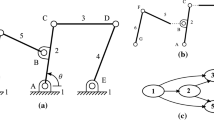Abstract
A new gluing algorithm is presented that can be used tocouple distributed subsystem models fordynamics simulation of mechanical systems. Using this gluingalgorithm, subsystem models can be analyzed attheir distributed locations, using their own independent solvers,and on their own platforms. The gluing algorithmdeveloped relies only on information available at the subsysteminterfaces. This not only enables efficientintegration of subsystem models, but also engenders modelsecurity by limiting model access only to the exposedinterface information. These features make the algorithm suitablefor a real and practical distributed simulationenvironment.
Similar content being viewed by others
References
Viswanadham, N., ‘The past, present, and future of supply-chain automation’, IEEE Robotics and Automation Magazine 9(2), 2002, 48–56.
Tseng, F. C., ‘Multibody dynamics simulation in network-distributed environments’, Ph.D Dissertation, University of Michigan, 2000.
Huddi, A. V. and Pidaparti, R. M. V., ‘Distributed finite element structural analysis using the client-server model’, Communications in Numerical Methods in Engineering 11, 1995, 227–233.
Kumar, S. and Adeli, H., ‘Distributed finite-element analysis on network of workstations – Algorithms’, Journal of Structural Engineering 121(10), 1995, 1448–1455.
Farhat, C. H. and Wilson, E., ‘A parallel active column equation solver’, Computers & Structures 28, 1988, 289–304.
Farhat, C. H. and Roux, F. X., ‘Implicit parallel processing in structural mechanics’, Computational Mechanics Advances 2, 1994, 1–124.
Craig, R. R., ‘Coupling of substructures for dynamic analyses: An overview’, in Collection of Technical Papers – AIAA/ASME/ASCE/AHS/ASC Structures, Structural Dynamics and Materials Conference, Reston, VA, Vol. 5, 2000, pp. 3–14, AIAA-2000-1573.
Tallec, P. L., ‘Domain decomposition methods in computational mechanics’, Computational Mechanics Advances 1, 1994, 121–220.
Kim, S. S., ‘A subsystem synthesis method for an efficient vehicle multibody dynamics’, Multibody System Dynamics 7, 2002, 189–207.
Featherstone, R., ‘Divide-and-conquer articulated-body algorithm for parallel O(log(n)) calculation of rigid body dynamics. Part 1: Basic algorithm’, International Journal of Robotics Research 18(9), 1999, 867–875.
Featherstone, R., ‘Divide-and-conquer articulated-body algorithm for parallel O(log(n)) calculation of rigid body dynamics. Part 2: Trees, loops, and accuracy’, International Journal of Robotics Research 18(9), 1999, 876–892.
Anderson, K. S. and Duan, S., ‘Highly parallelizable low-order dynamics simulation algorithm for multi-rigid-body systems’, Journal of Guidance, Control, and Dynamics 23(2), 2000, 355–364.
Duan, S. and Anderson, K.S., ‘Parallel implementation of a low order algorithm for dynamics of multibody systems on a distributed memory computing system’, Engineering with Computers 16(2), 2000, 96–108.
Sharf, I. and D'Eleuterio, G. M. T., ‘Parallel simulation dynamics for elastic multibody chains’, IEEE Transactions on Robotics and Automation 8, 1992, 597–606.
Kübler, R. and Schiehlen, W., ‘Modular simulation in multibody system dynamics’, Multibody System Dynamics 4, 2000, 107–127.
Gu, B. and Asada, H. H., ‘Co-simulation of algebraically coupled dynamic subsystems’, in Proceedings of the American Control Conference, Arlington, VA, Vol. 3, 2001, pp. 2273–2278 (IEEE cat n 01CH37148).
Tseng, F. C. and Hulbert, G. M., ‘A gluing algorithm for network-distributed dynamics simulation’, Multibody System Dynamics 6(4), 2001, 377–396.
Tseng, F. C., Ma, Z. D., and Hulbert, G. M., ‘Efficient numerical solution of constrained multibody dynamics systems’, Computer Methods in Applied Mechanics and Engineering 192, 2003, 439–472.
Hulbert, G. M., Michelena, N., and Ma, Z. D., et al., ‘A case study for network-distributed collaborative design and simulation: Extended life optimization for M1 Abrams tank road arm’, Mechanics of Structures and Machines 27(4), 1999, 423–451.
Fisette, P. and Peterkenne, J. M., ‘Contribution to parallel and vector computation in multibody dynamics’, Parallel Computing 24(5–6), 1998, 717–728.
Press, W. H., Teukolsky, S. A., Vetterling, W. T., and Flannery, B. P., Numerical Recipes: The Art of Scientific Computing, Cambridge University Press, Cambridge, 1992, pp. 425–428.
Author information
Authors and Affiliations
Rights and permissions
About this article
Cite this article
Wang, J., Ma, ZD. & Hulbert, G.M. A Gluing Algorithm for Distributed Simulation of Multibody Systems. Nonlinear Dynamics 34, 159–188 (2003). https://doi.org/10.1023/B:NODY.0000014558.70434.b0
Issue Date:
DOI: https://doi.org/10.1023/B:NODY.0000014558.70434.b0



